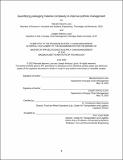| dc.description.abstract | Product portfolio complexity poses a significant challenge for many consumer packaged
goods (CPG) manufacturers, resulting in higher costs, risks, and production time. This
work aims to assist the sponsor company in managing and measuring its complexity and
determining the financial impact of delisting complex SKUs. We used a four-phase
methodology involving data collection and mapping, analytics, complexity analysis, and
financial analysis to achieve this. The complexity analysis was applied to the primary and
secondary packaging for a variety of product SKUs using the commonality index metric,
which indicates the frequency of components present in an SKU. We then connected this
metric with aggregated and granular financial metrics to identify the relationships between
complexity and costs. Our results showed that SKUs with a low commonality index exhibit
an average total cost 40.8% higher than those with a high commonality index.
Additionally, our results found that SKUs with a low commonality index had a packaging
materials cost that was 105% greater than SKUs with a high commonality index.
Therefore, modifying specific SKU components with low commonality makes cost savings
possible. We suggest using the commonality index and aggregated and granular financial
metrics as a guideline for delisting and introducing new products to effectively manage
and reduce supply chain complexity in the CPG industry. | en_US |
